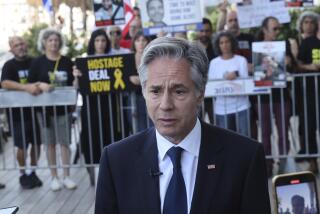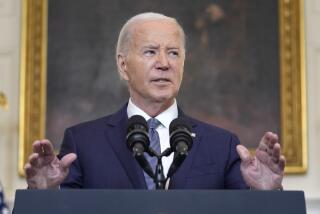U.N. Chief Backs U.S. Plan to Send Troops to Somalia : Africa: Boutros-Ghali prefers a U.N. force but endorses U.S. effort to protect aid. Awaiting Security Council approval, Administration seeks allied coalition.
UNITED NATIONS — Secretary General Boutros Boutros-Ghali gave a reluctant, conditional endorsement Monday to a U.S. plan to dispatch a division to force food and medicines past the warlords and their bandits into the hands of the starving millions in Somalia.
The plan now requires a formal resolution of approval from the Security Council, expected later in the week. But American officials, evidently expecting U.N. approval, moved swiftly ahead to prepare the plan for action.
The Bush Administration was working to put together a coalition of at least a dozen countries to take part in what would be a U.N.-authorized but U.S.-led operation. Administration sources said they expect European, African and Islamic nations to offer troops but that the key contingent would be a U.S. division of somewhere between 12,000 and 18,000 soldiers.
The force, modeled after the multinational coalition assembled against Iraq in the Persian Gulf War, would be commanded by an American with “lots of operational freedom,” a ranking U.S. source said. Neither the Americans nor others in the force would wear the blue helmets and blue berets of U.N. peacekeepers.
Boutros-Ghali would have preferred that the force don the traditional headgear and be U.N. peacekeepers. In a long letter to the Security Council, he listed options for the United Nations in face of the breakdown of the humanitarian relief operation in a ravaged Somalia, where warlords and their young henchmen steal food and medicines long before it reaches the needy.
The options ranged from complete withdrawal to acceptance of the proposal by Acting Secretary of State Lawrence S. Eagleburger that a U.S. division lead the way to the people of Somalia.
The secretary general said there is now no alternative but to use force, and he told the council he could approve only two of the options--”action under United Nations command and control” or, if that is not feasible, the Eagleburger plan.
This was interpreted by Security Council members as being tantamount to approval of the U.S. proposal. Ambassador Jean-Bernard Merimee of France said it was obvious that in the secretary general’s mind, “while one option is preferred, the other is the more realistic.”
U.S. Ambassador Edward J. Perkins, speaking carefully to reporters about the issue of U.N. or U.S. command, said the United States intends to do “whatever possible to support the United Nations but still maintain some sense of control over its forces.”
Boutros-Ghali proposed that the council impose conditions before it approves the U.S. plan. He said the council should set a time limit on the operation, with the United States and other governments providing periodic reports for U.N. review. He also said the operation should be prepared to give way later to a U.N. peacekeeping force that would help Somalia rehabilitate itself under a new, viable government.
He proposed that the council resolution state that “the purpose of the operation was to resolve the immediate security problem and that it would be replaced by a United Nations peacekeeping operation, organized on conventional lines, as soon as the irregular groups had been disarmed and the heavy weapons of the organized factions brought under international control.”
These conditions did not conflict with U.S. plans, Bush Administration sources said. After its “short-term mission,” they said, the U.S.-led coalition would withdraw and turn responsibility over to the United Nations, which would then be in charge of addressing the political friction and breakdown that spawned the Somali crisis.
U.S. officials said they hope the U.S. deployment would last no longer than six to eight weeks, although some acknowledged that chances of a longer deployment were high, mainly because they envisioned difficulties in transferring management of the crisis to the United Nations.
“We’re not worried about getting American boys out of Somalia,” a senior Administration source said. “From a technical standpoint, the first phase can be fairly easily and quickly addressed. The danger is the transition to the next phase.”
The second phase--Somalia’s reconciliation and rehabilitation--would involve long-term deployment of U.N. troops and require major donations or assessments to support it, the source said.
“It’s going to take a lot of glue to put Humpty Dumpty together again,” he said. “The secretary general is also going to have to go around with a tin cup to raise a lot of money.”
The Administration has been working on assembling a coalition force since last week, with President Bush placing phone calls to allies and asking for troops.
Once the force is assembled, the United States may try to tap financial support from wealthier nations that do not send troops, much as it did during the Gulf War.
The Administration dispatched Robert B. Oakley, a retired diplomat and former ambassador to Somalia, to Ethiopia on Monday to lay the groundwork for the expected dispatch of the U.S. troops to Somalia. He is to meet with Somali leaders and officials from governments supplying most of the relief to Somalia at a U.N. conference in Addis Ababa on Thursday and Friday.
Oakley is scheduled to return to Washington within a week and then return with U.S. troops as chief U.S. representative in Mogadishu. Brandon Grove, former U.S. consul general in Jerusalem, will be the main coordinator of the Somali operation in Washington, State Department sources said.
The Pentagon, meanwhile, began sending orders Monday to military commanders whose units likely would be involved in the operation, asking them to draft formal plans for such an operation and to specify the personnel and equipment they would need.
Senior Administration officials said the move was meant to formalize an earlier request to Marine Gen. Jay Hoar, commander in chief of the U.S. Central Command in Tampa, Fla., to hammer out a proposed overall battle plan and to compute how many troops and weapons would be required.
Although officials insisted that the action was not meant to speed up U.S. military preparations before the Security Council passes a resolution, it was clear that Gen. Colin L. Powell, chairman of the Joint Chiefs of Staffs, proposed an early deadline for setting the plan in motion.
The Administration earlier had offered up to 30,000 troops, but officials have insisted that the actual military operation in Somalia would probably require fewer soldiers; that was reflected Monday in the discussions of dispatching 12,000 to 18,000 troops.
After meeting with Eagleburger in Washington, African-American leader Jesse Jackson lent his support to the U.S. proposals. He dismissed fears that a U.S.-led operation would amount to a return to colonialism. He said the United States intends to act as part of a multilateral force.
“If this were a unilateral U.S. presence, searching for some material, some oil or some minerals or for some geopolitical positioning, one could justify those fears,” he said. “This simply is not the case.”
Meisler reported from the United Nations and Wright from Washington. Times staff writer Art Pine in Washington contributed to this report.
More to Read
Sign up for Essential California
The most important California stories and recommendations in your inbox every morning.
You may occasionally receive promotional content from the Los Angeles Times.










